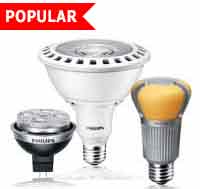Are LED Light bulbs Worth The High Cost?
The Republicans caved. In order to get the government spending bill passed, on Dec. 16, Republicans agreed to put on hold the implementation of a bill that would require more efficient light bulbs which, in the minds of many, meant the end of the much loved (and cheap) incandescent bulb. Proponents of the bill were quick to say that the incandescent bulb would still be available but in a more efficient form, and opponents argued that consumers should decide what kind of bulbs they buy instead of Congress.
According to the U.S. Department of Energy, consumers did decide. Energy and Commerce Secretary Fred Upton said, "We heard the message loud and clear from Americans who don't want government standards determining how they light their homes."
Americans are clearly opposed to the bill, but is it time we unshackle ourselves from the old incandescent bulbs and embrace new technology, and will our wallets thank us?
Is the Light Still Weird?
If you remember when compact florescent light bulbs first hit the market, the light they emitted was, for a lack of a more elegant term, weird. It was kind of green but also kind of white. It wasn't pleasing to the eye and as it warmed up, the light changed. This caused many to abandon the technology and go back to the incandescent bulb.
The new compact fluorescent bulbs are nearly indistinguishable from the old incandescent bulbs but once again, they're being abandoned for the new LED light bulb. LEDs power the new traffic lights, flashlights and TVs but now they can power your home and the light is described as a soft white light similar to incandescent bulbs.
The Calculations
Unless there's a good reason to purchase these bulbs, why pay the extra money? LED light bulbs are expensive. Prices start at $10 for a standard bulb and floodlights can cost as much as $100, but the cost of a bulb isn't as important as the money you pay to operate it.
First, let's assume that we're looking for the best way to produce 50,000 hours of light equal to an incandescent 100 watt light bulb. One, 100 watt incandescent bulb costs about 40 cents and to produce 50,000 hours of light, you'll need approximately 50 bulbs based on a life of 1,000 hours. That makes the cost of the bulbs about $20. Since an incandescent bulb requires 100 watts equal to 5,000 kilowatt hours of energy, that will cost more than $500 making the total approximate cost of our 50,000 hours of energy, $520.
Instead of 40 cents for the incandescent bulb, we had to pay $40 for the LED equivalent which, admittedly, is quite a case of sticker shock but to get 50,000 hours of light, we're only going to need two bulbs that use no more than 11 watts of energy equaling 540 kilowatt hours. The cost to power those bulbs is only about $58. Although we paid $80 up front, we had a total cost of only $138 or a 73% savings over the incandescent equivalent.
The Bottom Line
The above calculations will vary largely depending on the cost of the electricity as well as the current prices of light bulbs, but the cost savings of LED bulbs is clear. There's no doubt that the upfront cost of the more efficient bulbs is a stumbling block for some, if you can afford it, but the new LED bulbs offer a dramatic cost savings over the life of the bulb. How many light bulbs do you have in your home that could be replaced by LEDs?

















Comments